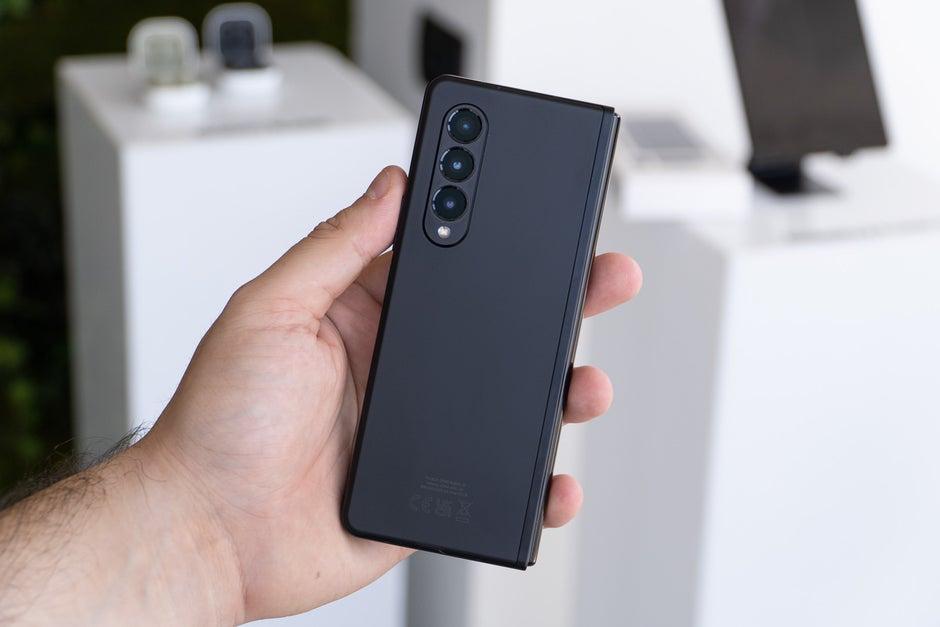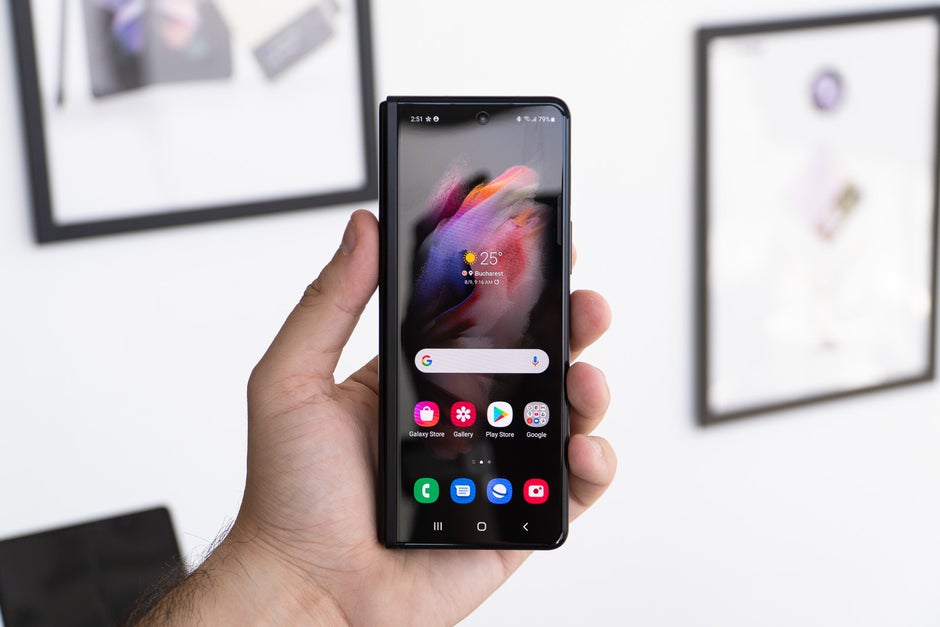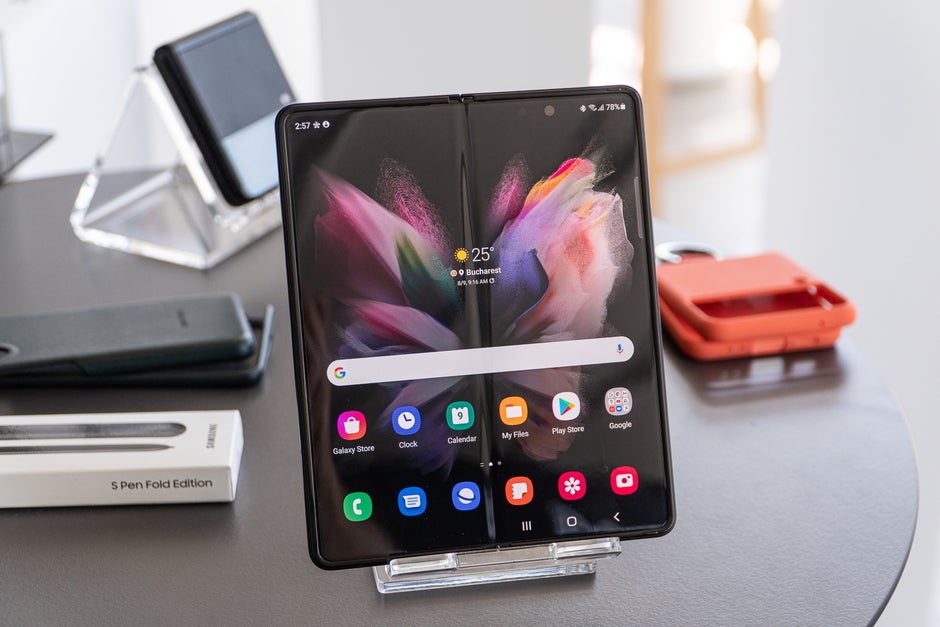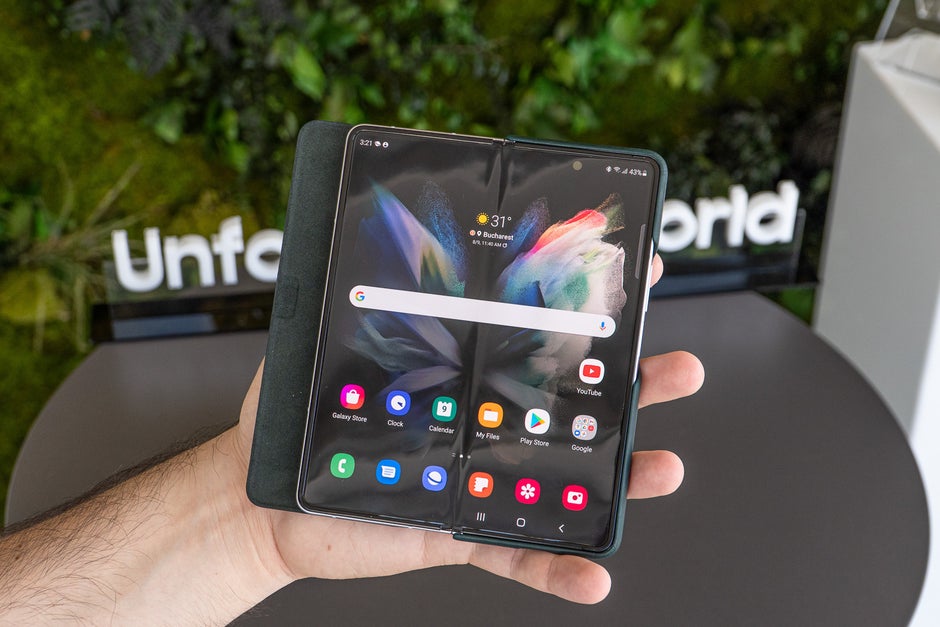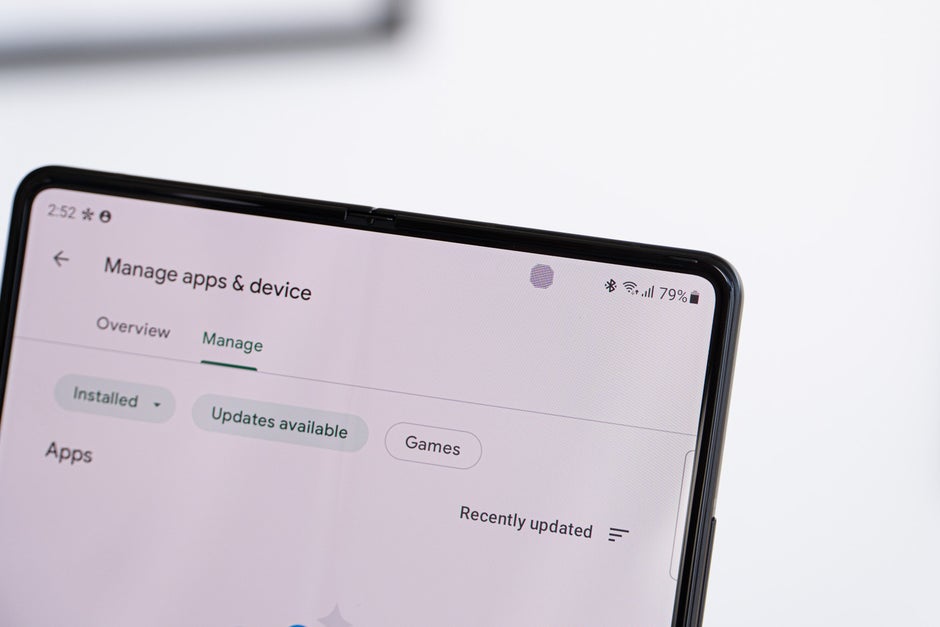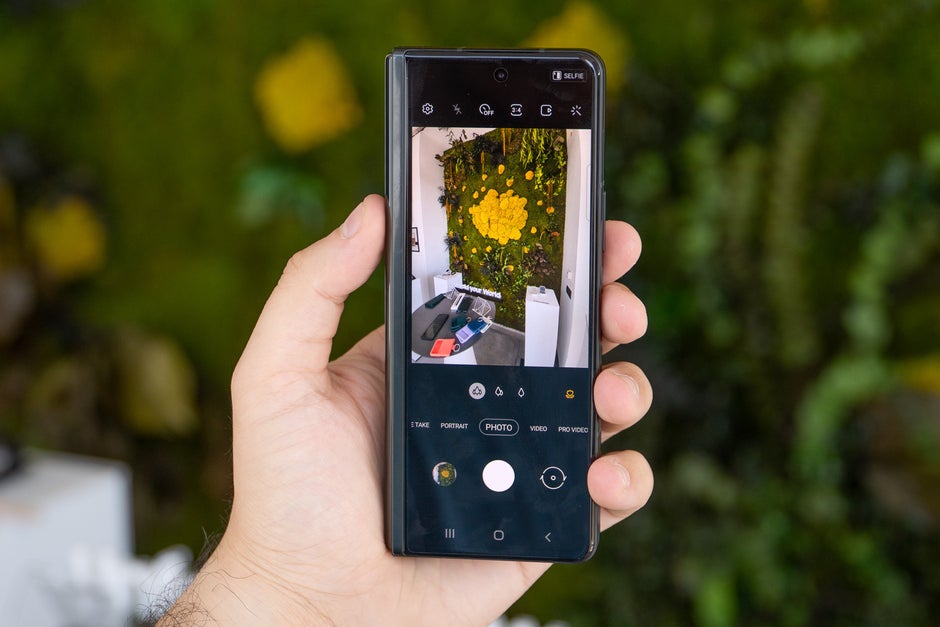Samsung Galaxy Z Fold 3 review: the story unfolds
As mentioned above, you can already score deals on the Galaxy Z Fold 3 pre-release. Check out the following offers and be sure to bookmark our “Galaxy Z Fold 3 deals and where to buy” page as we will be keeping it up to date.
Galaxy Z Fold 3 design and display
The camera on the back has gotten a redesign — it feels less bulky than last year’s model. That’s not to say it doesn’t protrude with its own camera hump, but it looks better and more elegant to my eyes. The back of the phone is covered in matte glass, which feels great and looks sleek. The black model we have here is overall very elegant and stealthy and I love the look.
Too bad the shell screen is so thin — it’s pretty tough, and even annoying, to thumb-type on it. Otherwise, the screen is good as a camera viewfinder, and it works for browsing social posts on Twitter and Facebook, checking your messages, calendar, using a calculator, et cetera. Any activity where you need to look up a bit of info quickly — it can do just fine.
The main screen
Of course, you will probably be using the main screen of your Z Fold 3 more often than the one on the shell.
This is where the experience of the hinge mechanism comes into play. It feels solid and tight and can confidently snaps into place when you unfold or close the Galaxy Z Fold 3. You can also choose to keep it into a half-open state and some apps will even respond to that by splitting the screen accordingly.
On to the inside screen — first pleasant surprise, the pre-installed screen protector feels great!
Small history lesson — the original Galaxy Z Fold had a screen protector, which was not supposed to be removed, because that litteraly broke the phone. The Galaxy Z Fold 2 had a removable protector, which had a very rubbery feel to it. Makes sense, a protector that’s laid on top of a screen that literally folds needs to be flexible, yeah? Though, the feel of that Z Fold 2 protector prompted a lot of users to remove it — it was sticky, nasty, and annoying.
The Galaxy Z Fold 3’s protector is a new flexible material that’s super-thin and has a pleasant, glossy feel — just what we are used to.
The main screen has a 7.6-inch diagonal and an almost-square (1.25:1) aspect ratio with a resolution of 2208 x 1768 pixels. Its overall screen area is about half of an iPad Pro 11 screen. In other words — it looks, feels, and functions as a mini tablet.
It’s a new type of Super AMOLED panel — Samsung calls this one Eco2 OLED. Essentially, it’s brighter and more energy-efficient than before. And it shows, I had no trouble viewing content under the bright sunlight on both the shell screen and inside display. The colors and sharpness are absolutely on point — Samsung has perfected its OLED game years ago and, by this point, it’s just showing off.
Display measurements and quality
It goes without saying that the inside screen also supports a 120 Hz refresh rate — last year’s model did it, so does this one. You know it — 120 Hz feels buttery smooth and responsive, it’s very hard to go back to 60 Hz screens after that.
Using the main screen to type longer messages is definitely easier than on the narrow outer one, but it’s still an acquired taste, or a skill that needs to be developed. There’s just no happy medium on this phone — you are either working with a super-small or extra-large keyboard. But I have a feeling I will get used to it the longer I actually use it.
On to the other big deal — the Galaxy Z Fold 3 is the first Samsung smartphone (and among the first smartphones in general) to have an under-screen selfie camera. A.K.A. under-panel camera or UPC. Specifically, it’s on the internal display. Instead of having a “punch-hole” opening for the selfie camera under the inner display, it’s now covered by active pixels. When the camera is not in use, the pixels will light up and try to “mask” the hole.
Is the UPC of the Z Fold 3 a good solution? In my opinion — not really. The area above the camera is covered by very few pixels, which also glow slightly brighter than the image on the rest of the display. Some have said it doesn’t look as bad in person as it does on camera. I dare argue this — it looks exactly like it does on camera.
But since everyone is busy ranting and raving about notches and punch-holes — there you have it. A half-done non-solution to a non-issue that now looks kind of dorky on an otherwise brilliant phone. Great.
Galaxy Z Fold 3 water resistance
One very big “first” debuting alongside with the Z Fold 3 is its water resistance. Yes, a foldable phone that’s not afraid of a little water is definitely something noteworthy. Have in mind that the phone is merely IPX8-rated, which means that it’s water-resistant, but not dust-resistant.
How has Samsung achieved this feat? Well, the company is pretty laconic for now, attributing the deed to its R&D team. I’ll take that as a clear win though, but then again, deliebrately dunking the phone in water is never advised.
Galaxy Z Fold 3 camera
The Samsung Galaxy Z Fold 3 does not aim to be the top dog in the camera department — Samsung has the Galaxy S21 Ultra for that. The Z Fold 3 does not have a crazy resolution sensor and it doesn’t have insanely over-the-top zooming.
I assume this choice was made for two reasons — first, to cut costs on a phone that’s already pretty expensive, and secondly to make sure that the camera is not super bulky. Can you imagine the Galaxy S21 Ultra’s camera module on the Z Fold? Yeah, a weight-lifter’s dream.
So, the Galaxy Z Fold 3 has a 12 MP main camera, 12 MP ultra-wide camera, and 12 MP telephoto camera that zooms 2x compared to the main one. The maximum zoom level you can get via digital crop is 10x.
Does this make the Z Fold 3’s cameras bad? No, not really. They are quite good. Not the best, but really good. Most of that is thanks to Samsung’s post-processing expertise, of course, as the phone does a lot of the heavy lifting once the sensor has captured the image.
Let’s look at some samples!
But other than that, the Galaxy Z Fold 3’s camera has a consistently good handle on dynamics — super-bright spots don’t burn out, dark spots get the exposure treatment they deserve. Even if it’s not the best camera Samsung has, the Z Fold 3’s shooter still behaves and performs like a flagship camera.
As for selfies, well — take your pick. You can use the 10 MP camera above the outer display to take a conventional selfie. It’s not super-good — it has a wide lens, so if you are not shooting in “group selfie” mode, the phone crops in digitally, and sharpness takes an instant hit.
Galaxy Z Fold 3 10 MP selfie camera
Its dynamics are also not great, but at least skintone and color balance don’t look too out there.
If you prefer — you can take selfies with the main camera module on the back. Just unfold the phone and use the cover screen as a viewfinder. It goes without saying that this results in the best, most unflatteringly detailed selfies you can make. It also gives you more options as you can use any of the 3 lenses on the back to take the selfie.
Galaxy Z Fold 3 selfies with main camera
Lastly, there’s the under-panel camera on the inside of the phone. It’s a 4 MP sensor hidden behind a display — it wasn’t really designed for selfies. Samsung said so itself — users use the inside camera mostly for video calls, and take selfies with the outside cameras. Of course, I tested the inside camera — it’s absolutely not great for any type of pictures, as expected. It works fine for Skype chats, though.
Galaxy Z Fold 3 under-panel camera
As for video, we get the same deal from the main camera — bright, vibrant, sharp imagery with a very good handle on dynamics. One thing we noticed — when zooming in and using the telephoto camera while recording, the phone has a bit of an issue auto-focusing right. It’s not a huge problem, but definitely something to be mindful of. User input may be required — tapping on your subject to prompt the camera to re-focus will help.
The resolution goes up to 4K at 60 FPS and the standard stabilizer does a good job at negating shaky hand effects. If you want to turn on Super-stable mode, you will be limited to FHD (1080p) at 30 FPS, so that’s a tradeoff.
For all the latest Technology News Click Here
For the latest news and updates, follow us on Google News.

